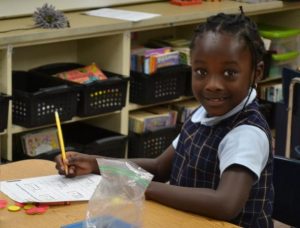 Our Philosophy
Our Philosophy
Welcome to the St. Francis first-grade program! We are pleased that you have considered St. Francis for your child. Our program continues to nurture the Catholic values instilled at home. Parents and teachers work cooperatively to build a partnership between home and school.
First grade is a time of growth and discovery. Children are learning many new skills, both academically and socially. They are beginning to learn about the world, and their place in it, and are awakening to a journey as lifelong learners.
First graders, throughout the year, make amazing strides in their reading, writing and mathematics skills. First graders also delve into a variety of content areas regarding science and social studies. Of course, at the heart of our curriculum is our Catholic faith. Our students are learning about God, their Creator and Loving Father; Jesus, His Son; and the gifts of the Holy Spirit.
Early elementary skills that our first-grade program targets for development include the following:
- Being a good listener
- Being kind to others
- Being careful at work and play
- Showing your best work
- Showing manners and respect
- Following multi-step directions
First-Grade Curriculum
Religion
Because we are a Catholic school family, we are able to learn about our faith, as well as live it. Our first-grade program, which includes Sophia Press – Spirit of Truth, helps the children to come to know Jesus and to celebrate the Good News. Through daily activities, prayers and practices, the children are invited to grow in faith as they come to understand God’s love, the life and teachings of Jesus, and what it means to belong to the Church. Our children learn to put faith into action by participating in Catholic service projects, which reach out to others within our local area and the world community.
Reading
CR Success Reading is a research-based literacy intervention program, which features a flexible and quick-paced approach. It combines systematic phonics and literacy-based instruction to create a streamlined, hands-on program that transfers immediately to the reading process. Using CR Success Reading, students learn letter and sound identification, blending, segmenting and manipulation of sounds.
Phonics/Spelling
Phonics lessons go hand in hand with the CR Success Reading program, eliminating the need for an additional text. Phonics skills learned throughout the year are beginning and ending consonant sounds, short and long vowels and vowel patterns, consonant blends, digraphs and word endings. First graders use CR Success concepts to learn to spell words in isolation and in context and to use correct spelling for high-frequency and phonetically regular words. The spelling of nonsense words are also used in our program and combined with reading.
Handwriting
First grade uses the Home Run Hitting handwriting series, which also complements the CR Success reading program. Proper posture and pencil control are important as students focus on the shape of each letter, how it is formed and where it falls on the handwriting guidelines.
Writing
First-grade writers use the Scholastic Traits Writing curriculum, which teaches various forms of writing (descriptive, narrative, expository, creative, persuasive, and literature response) and are taught through the 5-step writing process: prewriting, writing, revising, editing and publishing. Embedded in this writing curriculum is instruction on the six traits of good writing: ideas, organization, voice, word choice, sentence fluency and conventions.
Math
Our comprehensive math program helps first graders develop their thinking skills in a variety of ways. Sadlier Math includes different opportunities for students to develop their mathematical skills through group lessons and guided independent practice. During our lessons, students will use real-world problem solving and applications related to STEAM.
Social Studies
First graders learn about community, basic economic principles, and respect for our country and its symbols. Other social studies units include history, presidents and geography.
Science
First graders are instructed in a variety of science units using Mystery Science. Students enjoy hands-on investigations; introducing them to observation skills and methodological approaches needed in science. Other units include physical science, animal and plant units, earth science and health topics.
Enrichment
Spanish
Students begin to develop writing skills by recognizing and writing numbers. Food, animal and clothing vocabulary is introduced. Students learn whole Spanish songs and develop their conversation and speaking skills through cooperative learning games that introduce vocabulary in a fun way. Bingo, telephone and Tingo Tango are among these games used. Spanish is taught for 30 minutes per week
Specials
Each week our first graders participate in art, music, gym, computer and library classes. In addition the children also benefit from additional enrichment in the form of special assemblies and programs.
Recess/Lunch
Every day, first graders enjoy 25 minutes of outdoor recess time followed by a 25-minute lunch period. Recess and lunch are supervised by parent helpers.